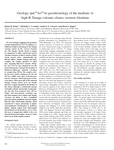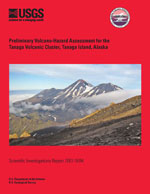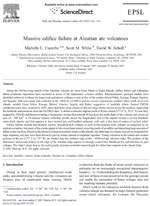Sajaka Two, Sajaka One
Start: 3200 yBP ± 4700 Years [1]
Event Type: Explosive
- Lava flow [1]
- Pyroclastic flow, surge, or nuee ardente [1]
Description: From Jicha and others (2012): "Sajaka is the westernmost center of the Tanaga volcanic cluster and the least silicic of the Holocene volcanoes. All analyzed lavas contain less than 51 wt% SiO2. Sajaka One is a truncated stratocone mantled by thick fall deposits from Tanaga and Sajaka Two. A columnar-jointed basalt from near the top lavas along the southern shoreline yielded a 40Ar/39Ar age of 3.2+/-4.7 ka. Nearly the entire western half of Sajaka One was destroyed by a sector collapse directed to the west. The resultant submarine debris-avalanche deposit is visible in multibeam bathymetry (Coombs and others, 2007a) and extends at least 9 km offshore but is not preserved on the island. This collapse appears to have been contemporaneous with the emplacement of pyroclastic-flow deposits along the northern contact between Sajaka One and Sajaka Two (Fig. 5D [in original text]). The pyroclastic-flow deposit (unit sop) is up to 60 m thick and contains ~70% lithic lapilli and ~30% scoria lapilli in a crystal-rich, ash matrix. The 290-m-high wall created by the sector collapse consists of thin (<1 m to 2 m) Sajaka One lavas, scoria-fall deposits, and lithic-rich pyroclastic-flow deposits."
From Coombs and others (2007): "Sajaka’s eruptive history can be broken into two parts. Sajaka One started to grow several thousand years ago, forming a cone likely to have been similar to those of Tanaga and East Tanaga. The eastern half of the Sajaka One edifice is still intact, but the western half is missing (fig. 11 [in original text]). A new, younger cone (Sajaka Two) has grown in the scar. The removal of Sajaka One’s western half probably was caused by a landslide. Recent bathymetric mapping of the seafloor west of Sajaka revealed a debris field with several large blocks in the areas within the failure scarp of Sajaka One (Coombs and others, 2007). On land, no debris-avalanche deposit has been recognized, but outcrops of a pyroclastic-flow deposit were detected on top of Sajaka One lava. The presence of the pyroclastic-flow deposit indicates the collapse may have been accompanied by an explosive eruption, or possibly a lateral blast (Siebert, 1984). The lower part of the Sajaka One amphitheatre is obscured by the new Sajaka Two cone; however, the upper reach of the Sajaka One edifice is truncated by a 1.5-km-diameter crater that resembles those at Bezymianny, Russia, and Mount St. Helens, Washington, other volcanoes that have experienced lateral blasts (fig. 6 [in original text]). The age of the Sajaka One collapse is thought to be a few thousand years ago, because lava from beneath the pyroclastic-flow deposit and from the Sajaka Two cone yield radiometric ages of 5,000 years to present."
From Coombs and others (2007): "The earlier edifice, Sajaka I, was truncated nearly in half, with a new, younger cone (Sajaka II) growing in the scar. The resulting debris-avalanche deposit is now below sea level, but limited subaerial exposures show a pumiceous pyroclastic flow deposited on Sajaka I lavas. The presence of the pyroclastic-flow deposit suggests that this sector collapse may have been accompanied by an explosive eruption. The lower part of the Sajaka amphitheatre is obscured by the new cone, but the upper reach of the Sajaka I edifice is truncated by a 1.5-km-diameter crater that resembles those at Bezymianny and Mount St. Helens, where landslides were accompanied by eruptions as pressure was released on shallow magmatic intrusions [41].The age of the Sajaka collapse is late Holocene, because lavas from beneath the pyroclastic-flow deposit and from the Sajaka II cone yield 40 Ar/ 39 Ar ages of 5-0ka(A. Calvert, unpublished data)."
From Coombs and others (2007): "Sajaka’s eruptive history can be broken into two parts. Sajaka One started to grow several thousand years ago, forming a cone likely to have been similar to those of Tanaga and East Tanaga. The eastern half of the Sajaka One edifice is still intact, but the western half is missing (fig. 11 [in original text]). A new, younger cone (Sajaka Two) has grown in the scar. The removal of Sajaka One’s western half probably was caused by a landslide. Recent bathymetric mapping of the seafloor west of Sajaka revealed a debris field with several large blocks in the areas within the failure scarp of Sajaka One (Coombs and others, 2007). On land, no debris-avalanche deposit has been recognized, but outcrops of a pyroclastic-flow deposit were detected on top of Sajaka One lava. The presence of the pyroclastic-flow deposit indicates the collapse may have been accompanied by an explosive eruption, or possibly a lateral blast (Siebert, 1984). The lower part of the Sajaka One amphitheatre is obscured by the new Sajaka Two cone; however, the upper reach of the Sajaka One edifice is truncated by a 1.5-km-diameter crater that resembles those at Bezymianny, Russia, and Mount St. Helens, Washington, other volcanoes that have experienced lateral blasts (fig. 6 [in original text]). The age of the Sajaka One collapse is thought to be a few thousand years ago, because lava from beneath the pyroclastic-flow deposit and from the Sajaka Two cone yield radiometric ages of 5,000 years to present."
From Coombs and others (2007): "The earlier edifice, Sajaka I, was truncated nearly in half, with a new, younger cone (Sajaka II) growing in the scar. The resulting debris-avalanche deposit is now below sea level, but limited subaerial exposures show a pumiceous pyroclastic flow deposited on Sajaka I lavas. The presence of the pyroclastic-flow deposit suggests that this sector collapse may have been accompanied by an explosive eruption. The lower part of the Sajaka amphitheatre is obscured by the new cone, but the upper reach of the Sajaka I edifice is truncated by a 1.5-km-diameter crater that resembles those at Bezymianny and Mount St. Helens, where landslides were accompanied by eruptions as pressure was released on shallow magmatic intrusions [41].The age of the Sajaka collapse is late Holocene, because lavas from beneath the pyroclastic-flow deposit and from the Sajaka II cone yield 40 Ar/ 39 Ar ages of 5-0ka(A. Calvert, unpublished data)."
References Cited
[1] Geology and 40Ar/39Ar geochronology of the medium- to high-K Tanaga volcanic cluster, western Aleutians, 2012
Jicha, B.R., Coombs, M.L., Calvert, A.T., and Singer, B.S., 2012, Geology and 40Ar/39Ar geochronology of the medium- to high-K Tanaga volcanic cluster, western Aleutians: Geological Society of America Bulletin, v. 124, n. 5/6, p. 842-856, doi:10.1130/B30472.1 .[2] Preliminary volcano-hazard assessment for the Tanaga Volcanic Cluster, Tanaga Island, Alaska, 2007
Coombs, M.L., McGimsey, R.G., and Browne, B.L., 2007, Preliminary volcano-hazard assessment for the Tanaga Volcanic Cluster, Tanaga Island, Alaska: U.S. Geological Survey Scientific Investigations Report 2007-5094, 36 p., available online at: http://pubs.usgs.gov/sir/2007/5094/ .[3] Massive edifice failure at Aleutian arc volcanoes, 2007
Coombs, M.L., White, S.M., and Scholl, D.W., 2007, Massive edifice failure at Aleutian arc volcanoes: Earth and Planetary Science Letters, v. 256, p. 403-418, doi: 10.1016/j.epsl.2007.01.030.Complete Eruption References
Geology and 40Ar/39Ar geochronology of the medium- to high-K Tanaga volcanic cluster, western Aleutians, 2012
Jicha, B.R., Coombs, M.L., Calvert, A.T., and Singer, B.S., 2012, Geology and 40Ar/39Ar geochronology of the medium- to high-K Tanaga volcanic cluster, western Aleutians: Geological Society of America Bulletin, v. 124, n. 5/6, p. 842-856, doi:10.1130/B30472.1 .

Preliminary volcano-hazard assessment for the Tanaga Volcanic Cluster, Tanaga Island, Alaska, 2007
Coombs, M.L., McGimsey, R.G., and Browne, B.L., 2007, Preliminary volcano-hazard assessment for the Tanaga Volcanic Cluster, Tanaga Island, Alaska: U.S. Geological Survey Scientific Investigations Report 2007-5094, 36 p., available online at: http://pubs.usgs.gov/sir/2007/5094/ .

Massive edifice failure at Aleutian arc volcanoes, 2007
Coombs, M.L., White, S.M., and Scholl, D.W., 2007, Massive edifice failure at Aleutian arc volcanoes: Earth and Planetary Science Letters, v. 256, p. 403-418, doi: 10.1016/j.epsl.2007.01.030.
